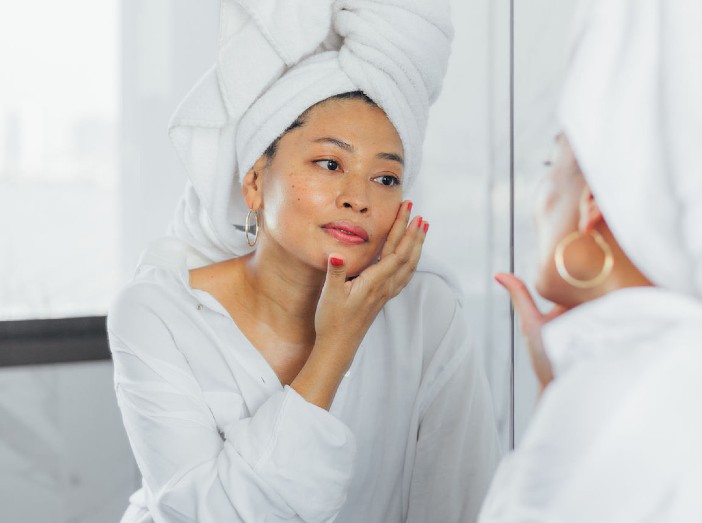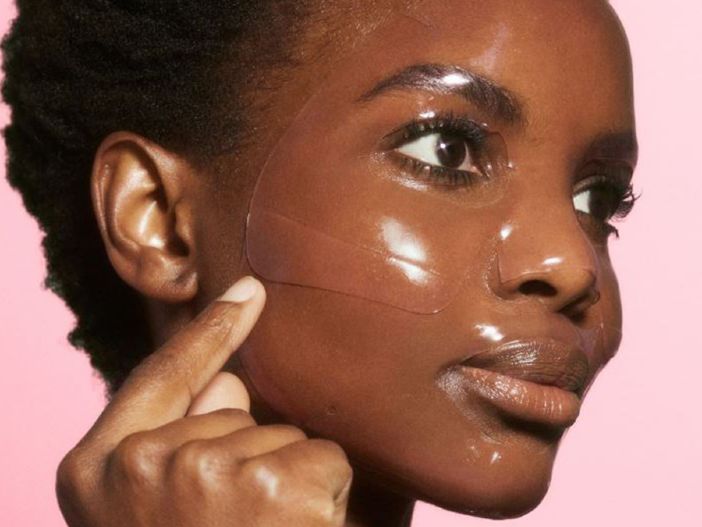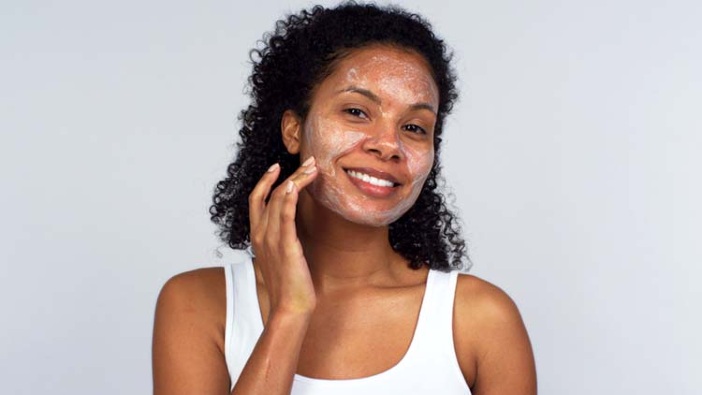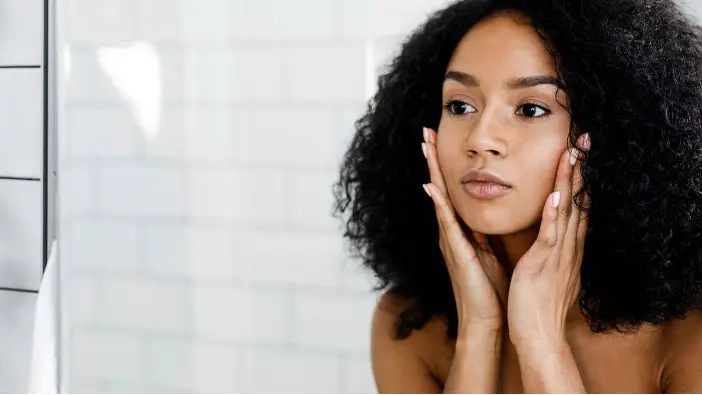A skincare routine is more effective when you have identified your skin type as either dry, oily, normal, or combination skin. People tend to quickly pronounce their skins normal, dry, or oily. And, sometimes it’s a way to avoid the seemingly “complex” combination skin.
Having combination skin is not an issue. It is just as peculiar as every other skin type. Generally, healthy, glowing, and flawless skin is achieved through a proper and appropriate skincare routine. Combination skin is no exception to this.
With combination skin, however, you may sometimes feel like you’re in two different skins at different times. This is the only complexity. But, when you come to terms with this, caring for your skin becomes easy and you’ll love your skin more than before.
This article contains everything you should know about your combination skin and its needs.
What Is Combination Skin?

As earlier mentioned, combination skin could feel like you have different skin types at almost the same or different times.
A licensed esthetician, Lily Njoroge, explains combination skin this way, “combination skin encompasses people who have two of the other skin types both present on their face”.
With this skin type, you’ll find that certain areas of your face like your T-zone (forehead, nose, and chin) are oily. On the other hand, your mouth and cheek areas are dry. Beauty experts assure that this is not in any way a skin condition.
Although skin type is fluid; it could fluctuate with seasonal and hormonal changes. That means, at different stages of life or times of the year, everyone is most likely to have the combination skin type.
Beyond these factors, some people are definitively the combination skin type. So, just as people with dry and oily skin types take extra care of their skin, you should do the same.
Signs of Combination Skin
There are telltale signs that say you do not have oily skin although you experience an overproduction of sebum. Also, certain signs clear the assertion that the occasional flakiness means you have dry skin. These signs include:
- Naturally oily T-zone and dry cheeks
- Few minutes after washing and drying your face, you notice oiliness in only your T-zone
- Oily, glowing skin during summer but dry, flaky skin in winter
- In seasons like spring and fall, you may have oily T-zone and dry cheeks
- During your menstrual cycle, you may have skin breakouts when your period starts. And, when it is over, the breakouts clear and leaves you with flaky skin
- Larger and more visible pores on your nose than on your cheeks and jawline
- Scalp dandruff
- You may sometimes experience flakiness on your T-zone
- Skincare products for normal skin types have different effects on different areas of your face
Causes of Combination Skin
Renee Rouleau, a celebrity esthetician, says “combination skin is a standard term in the skincare industry. It is not at all connected with skin conditions such as discoloration, loss of tone, eczema, acne or rosacea”.
These are the possible reasons why you have combination skin:
- Genetic predisposition
- Overactivity of oil glands around certain areas of your skin
- Weather and hormonal changes
- Stress
- Exposure to the sun without wearing sunscreen
- Skincare products
- Menstruation
- Use of contraceptives
Skincare Routine for Combination Skin

Brendan Camp, MD, says, “While there may be no one-size-fits-all regimen, building a foundational skincare routine that can be modified to suit a person’s needs is a good place to start”.
Skincare routine for your combination skin type should not be stressful or confusing. The knowledge of the peculiarities of your skin type should guide you in shopping for skincare products. Also, you should get products with formulations that suit your skin pores.
Proper skin care for your combination skin should follow a daily; morning and night, and a weekly routine.
1. Daily Combination Skincare Routine
Cleanser
Every effective skincare regimen begins with cleansing your face with a good facial cleanser. After a morning bath, use a cleanser to gently clean your face of the oil that must have secreted over the night. Moreover, cleansing makes your face a clean slate for other beauty care products.
After the day’s activities and an evening bath, double cleanse your face to get rid of makeup, grime, dirt, sunscreen, and oil residues. The morning and evening cleansing make sure that oil and moisture balance is restored to your skin.
Most importantly, the skin on your face does not need products with harsh chemicals. It also doesn’t require scrubbing. All you need to do is dampen a cotton pad with cleanser and apply it to your face. Apply by rubbing gently in circular motions.
Scrubbing and using harsh chemicals will rid your skin of hydration and moisture. This will expose the dry areas of your face to more dryness. Also, the oily areas (your T-zone) will overcompensate by secreting more oil. Consequently, this will lead to clogged pores and skin breakouts.
So, when you go skincare products shopping for your combination skin, buy a fragrance-free, non-comedogenic cleanser like CeraVe Hydrating Cream to Foam Cleanser. This cleanser works well for both your morning and evening cleansing.
It gently cleanses your face of natural buildup, makeup and leaves your skin hydrated. The cream texture foams into a lather as you apply it to your skin. This helps to keep your skin’s natural barrier and moisture intact.
Toner
Toners come after you have cleansed your skin. The peculiarities of your combination skin require a calming toner. Toners contain ingredients that clean beyond the superficial skin areas. They can penetrate your skin and clean the pores.
Use a toner in the morning to get rid of excess oil that must have been produced overnight. Then, at night, it gets rid of grime, makeup, and sunscreen residue.
Toners are made of acids like salicylic acid, glycolic acid, and lactic acid. Skin experts say these acids synergize to exfoliate your skin and keep it hydrated. This way, your skin is protected from acne breakouts and premature aging.
Moreover, the appropriate toner for your combination skin helps to balance your skin’s pH levels and reduce the appearance of your pores. Paula’s Choice Skin Balancing Pore-Reducing Toner is an unscented, alcohol-free that works well for your skin.
This toner is formulated with antioxidants and ceramides that protect your skin from breakouts and simultaneously evens your skin. You can use this lightweight, calming, and paraben-free toner for both your morning and evening routine.
SEE: A Complete Guide On How to Use Face Toners Effectively
Face Serum
Generally, serums open up your skin to receive skincare products that are weightier than cleansers and toners. So, just before you use a moisturizer or night cream, gently apply some serum to your face using your fingertips; make sure you do not rub it in.
For combination skins, serums help to manage breakouts, even your skin and get rid of wrinkles. So, you should buy a serum that addresses every skin condition your skin could be prone to.
Serums, especially retinol-based serums, help to balance your combination skin. They ensure that your skin does not feel too dry or too oily. Also, they balance your pores after the exfoliating effect of toners. This way, they restore moisture to your skin.
A hydrating serum like Neutrogena Hydro Boost Hydrating Hyaluronic Acid Serum best cares for your skin type and its concerns. Hyaluronic acid serums keep your skin hydrated and moisturized. Also, this serum is oil-free and non-comedogenic.
However, serums that contain vitamin C and retinol are photosensitive. So, if you use a serum like this, make sure you wear sunscreen before stepping out. On the other hand, all serums work better at night. This is when they effectively carry out their skin-repairing function.
Moisturizer
Every skin type needs a moisturizer even after using a serum. As part of the skincare routine for your combination skin, you’ll need a moisturizer that keeps your skin hydrated and moisturized. Some dermatologists recommend that you go for an oil-free moisturizer.
But, you may get two moisturizers; a creamy moisturizer for the dry areas and a lightweight, water-based moisturizer for your oily T-zone.
The former will furnish the dry areas of your skin with extra hydration while the latter would cut out extra shine but leave your skin moisturized and soft. However, this could be getting too much product on your skin at a time.
Use Neutrogena Oil-Free Moisture for Combination Skin to moisturize and balance your skin in the morning and evening. This moisturizer is a lightweight lotion that hydrates the dry areas of your skin and also controls shine on the oily areas.
For the peculiarities of combination skin that could make it sometimes sensitive, you should use a moisturizer like this that is fragrance-free and hypoallergenic.
Read Also: Does Moisturizer Go Bad? Experts Highlight How to Spot One
Sunscreen
Sunscreens seal your morning skincare routine with protection. So, if you have used any photosensitive skincare product, sunscreens are the best backups you’ll find. It also protects your skin from the damages of the sun’s UV rays.
You should know that your combination skin needs sunscreen as much as any other skin type does. Too frequent exposure to sunlight can cause dehydration and worsen acne breakouts; consequently leading to hyperpigmentation.
Sunscreen is not needed at night unless you used a moisturizer with SPF. For your morning routine (if you didn’t use a moisturizer with SPF), use EltaMD UV Clear Facial Sunscreen Broad Spectrum SPF 46 thirty minutes before exposure to the sun rays.
This sunscreen contains zinc oxide which protects your skin from the effect of UV rays and prevents skin conditions like acne and rosacea.
2. Weekly Skincare Routine for Combination Skin

Exfoliation
Exfoliation removes dead skin cells and excess oil which clog your pores and cause flakiness. You should not exfoliate your skin beyond how much is necessary which is once or twice a week. Otherwise, you could be exposing your skin to dryness and inflammation.
Exfoliate your face in the morning with a chemical exfoliant that is not as harsh as a physical exfoliant. A BHA exfoliator like Paula’s Choice Skin Perfecting 2% BHA Liquid Exfoliant helps to unclog pores, and exfoliate your skin leaving it smooth and less oily.
In addition, it is a leave-on exfoliant that helps to shrink pores and reduce the appearance of wrinkles. It is also fragrance and paraben-free.
SEE: How to Exfoliate Your Skin: Your Skin Type Is Your Safety Compass
Face Mask
As part of your weekly combination skincare routine, use a face mask once a week. Apply face masks to the oily areas of your skin to remove excess sebum, grime, dirt, and makeup. It gets rid of these impurities and shrinks your pores.
Kiehl’s Rare Earth Deep Pore Cleansing Masque contains aloe vera which makes it soothing to the skin. You can also practice multi-masking by using two different types of masks; one for the oily areas and one for the dry areas.
Additional Tips for Combination Skincare Routine

- Do not use harsh soaps
- Avoid touching your face unnecessarily
- Use an eye cream if and when necessary
- Always clean your makeup before going to bed
- Use blotting paper to soak up excess oil from oily areas
- Exfoliate gently
- Apply skincare products with a clean hand
- Watch out for products’ ingredients makeup
- Talk to a dermatologist when necessary
Frequently Asked Questions

1. Why do I have combination skin?
Certain fixed factors like genetic predisposition and weather changes play vital roles in determining skin type. So, you could have combination skin as a result of having a parent who has combination skin or due to weather and seasonal changes.
Also, it could be a result of changes in hormonal levels during menstruation or the use of contraceptives.
2. What is normal combination skin?
Normal combination skin defines both types of skin present on your face. With this classification, it is seen that the skin on your cheeks is neither dry nor oily but the skin on the T-zone area is oily.
3. Does my diet affect my skin?
Yes, it does. Overconsumption of certain foods like carbohydrates and processed foods can lead to excess blood sugar. Consequently, this triggers the secretion of a hormone called insulin; to remove the excess blood sugar.
When your blood has excess insulin, it triggers skin inflammation and overproduction of oil by the oil glands. This is the onset of acne breakouts.
Conclusion
An understanding of your skin type; its peculiarities and needs is very important if you’ll achieve satisfying results. Having combination skin is as normal as having a normal skin type. It is not a sign of deficiencies or a skin condition.
The skincare routine for your combination skin doesn’t have to be anything complex. Follow the right skincare routine consistently to get your desired results. Combination skin plumps and glows when showered with a lot of TLC.
Most importantly, skincare is not about how much but how well a product will work. And, it’s better to treat your skin to products that meet the current needs rather than bombarding your skin with products.
Thanks for reading.
Check Africana Fashion for relevant skincare articles that will help you achieve healthy, glowing skin.






